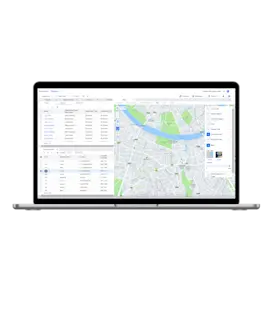Sustainable Logistics 101: A Guide for Growing Fleets
Sustainable Logistics 101: A Guide for Growing Fleets
Sustainable Logistics 101: A Guide for Growing Fleets
24 Mar 2022
Aptean Staff Writer
Green business practices and sustainability are the name of the game for logistics companies right now. New government regulations and increased public demand for accountability and corporate stewardship have forced transportation industry leaders to look for sustainable logistics solutions.
A lot of the focus at the moment is on the advantages of introducing electric vehicles to fleets. But that’s an expensive change that’s going to take some time. If you’re trying to amplify your sustainability efforts, you don’t need to replace all your fleet vehicles immediately—instead, a simple investment in route optimization software with proof of delivery tools will boost your green trucking strategy right now.
What Is Sustainable Logistics?
For logistics companies, your sustainability efforts will set the stage to lower carbon emissions due to the major role that transportation companies play in maintaining the supply chain. This means that green or sustainable trucking is an essential issue for logistics; not only because consumers worldwide are demanding environmentally friendly business practices, but because lowering carbon emissions is simply the right thing to do.
In addition, worldwide government regulations are restricting carbon emissions with stricter targets, so getting ahead of legislative changes will help you stay competitive.
The goal of sustainable logistics is for truck fleets to slash their environmental footprint. Transportation companies can achieve this by reducing carbon emissions, decreasing idling and cutting excess paperwork. The challenge here is how logistics companies can reduce greenhouse gas (GHG) emissions while the demand for logistics services skyrockets.
In the following blog post, we’ll discuss how technology will help your transportation company uphold a sustainable logistics plan and still meet your tight delivery deadlines—all while boosting profits.
How to Create a Greener Transportation Program
Most aspects of the supply chain produce carbon emissions, but last mile delivery is the biggest culprit; it’s also the fastest-growing aspect. For many fleets, trying to reduce their environmental impact without sacrificing delivery efficiency seems impossible. But you don’t have to choose one over the other; instead, focus on sustainability by doing several things:
Optimizing routes
Decreasing empty miles
Cutting down on idling
Reducing manual, paper processes
The key is to balance your company’s financial health with green practices and yet still manage your deliveries in a timely manner. Let’s investigate how you can achieve each of these objectives.
Optimizing Routes
In a recent study, the Environmental Protection Agency concluded that the transportation sector produces more greenhouse gases than any other sector. The trucking industry is responsible for almost 29% of all GHGs. At the same time, consumers are more environmentally aware. In fact, more than 50% have stated that they would be willing to pay more for products and services that had a proven track record of environmental responsibility.
For logistics companies, this means that they must reduce the number of miles that their fleet drives every year. The easiest way to reduce truck miles is with intelligent route optimization software. Manual planning is tedious and inefficient. With routing and scheduling software, your fleet’s routes are planned and executed using sophisticated algorithms configured specifically for the needs of your delivery operation. And as issues arise, the software will help identify these issues and allow the user to make adjustments. Overall, the software reduces route times and driver hours which leads directly to lower truck miles and lower fuel costs, as well as reduced overtime hours.
After installing the software, some companies reported that they reduced their truck fleets by 20%. Because the fleet is more efficient, they can deliver the same products with fewer trucks. Each truck typically generates hundreds of tons of carbon dioxide emissions in its lifetime, so if you can reduce even one truck out of the fleet, this adds up to a direct decrease in greenhouse gas emissions. In a notable real-life example, Martin Brower, a leading restaurant chain distributor, reduced GHGs immediately by some 900,000 pounds per week, simply by adopting Aptean’s routing and scheduling software.
Decreasing Empty Miles
The simplest way to enhance fleet sustainability is the intelligent use of all resources, specifically drivers and trucks. By effectively pairing loads for all depots to driver shifts you can achieve significantly better asset utilization. The Integrated Fleets module of Aptean's route optimization software treats vehicles and drivers at multiple sites as a single integrated resource pool. Therefore, movements from different depots are combined into efficient routes that reduce overall empty running.
The tool can also generate route plans that include backhauls which further increases asset utilization, improves productivity and reduces empty mileage. Advanced route optimization software identifies opportunities to pick up another load on the way back to the distribution center after the initial route is done. Planning backhauls can lead to a new revenue stream due to inbound credits from your suppliers.
Cutting Down on Idling
You know that excessive idling is a waste of money in both fuel and truck maintenance; but it’s also bad for the environment. All drivers have normal idle time—they will have to stop at traffic lights and stop signs as well as toll booths and the loading and unloading time at the DC and your customers.
What are the costs of excessive idling? According to the EERE, excessive idling costs approximately $12,000 per fleet truck per year. Also, for every 10% of idle time, the truck loses a 1% decline in fuel economy. Using intelligent route optimization software, you can plan more accurately. That means that you are more precise in delineating arrival times at delivery destinations. Your drivers can consistently meet time windows, so deliveries are processed faster. And, they can unload and be on their way faster, fitting more deliveries into their allotted hours of service.
Because they aren’t idling in line, you’ll save fuel and reduce GHGs—all with the touch of a button.
Reducing Manual Paper Processes
Route optimization software with a proof of delivery application replaces piles of invoice paperwork or eliminates it altogether. Because they don’t have to fill out paper forms at every stop, drivers can get their delivery tasks completed faster. This means you can add more jobs to each route or try expanding your service offerings.
It simplifies your current processes. You don’t have to wait for drivers to return and then enter the data from the paperwork, nor will your office staff have to manually enter data into the system. With an electronic proof of delivery system, you get accurate and detailed data in real time—imagine having this real-time data to manage customer disputes to credit inquiries?
This not only removes errors caused by manual data entry, but it can also speed up billing and ensures accuracy in inventory management. In addition, it simplifies customer service issues. If an order is delayed, you and your customer will know in real time with an integrated routing system, and your service team can contact the customer to discuss the issue. Your team gains efficiency across all aspects of the logistics operation, and you’ll save time, money and paper—all of which boosts your green trucking strategy.
The Intelligent Choice for Sustainable Logistics
Green trucking doesn’t have to mean spending hundreds of thousands of dollars to replace your fleet. Instead, use routing software and electronic proof of delivery to reduce inefficiencies in your logistics enterprise. Intelligent, optimized routing leads to fewer trucks on the road, and those trucks drive more efficient routes.
Robust route planning software helps you use your fleet’s resources to the fullest. As a result, you reduce truck miles, decrease empty running, use fewer trucks and increase the utilization of your drivers—all of which saves money and reduces your carbon footprint.
We know that when you’re looking at options for routing software, reducing carbon emissions is probably not a big factor in your decision. However, enhancing delivery route efficiency by implementing routing and scheduling software will save you money in transportation costs and help you grow your business. Why not reduce your carbon footprint at the same time?
Are you concerned about sustainable logistics? Want to know more about driving efficiency for your transportation business? Find out how, now.
Ready to start transforming your business?
We've got the specialized TMS solutions you need to conquer your industry challenges.



